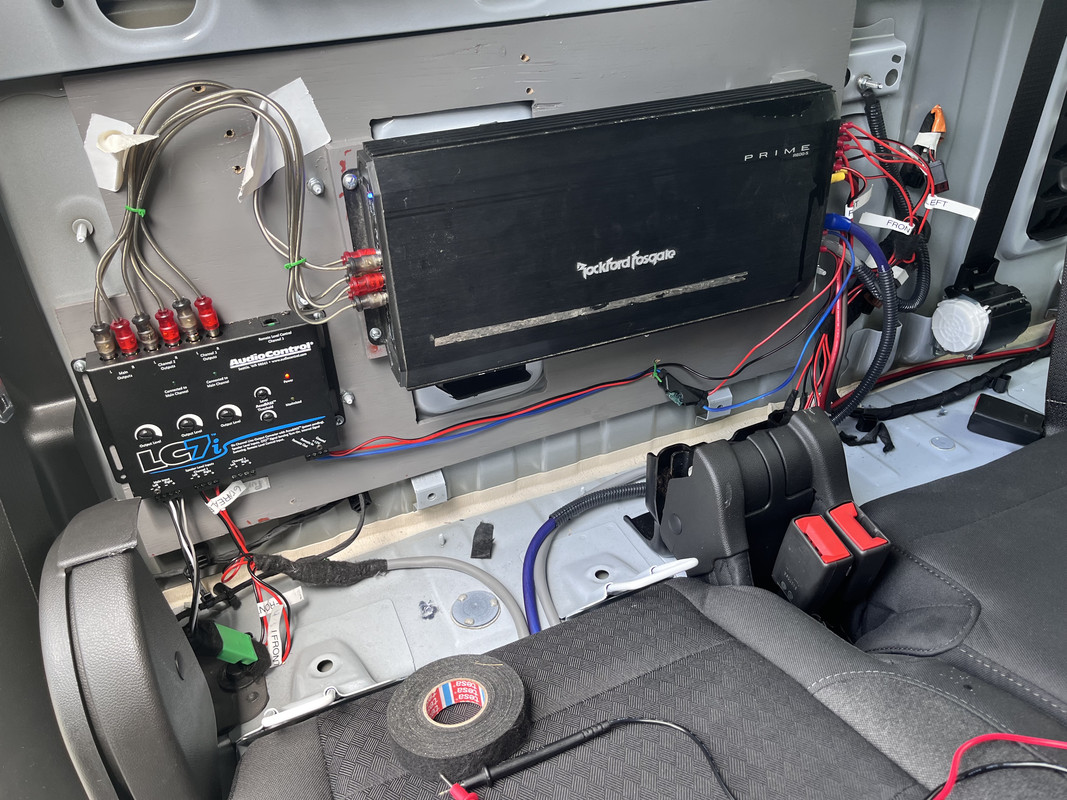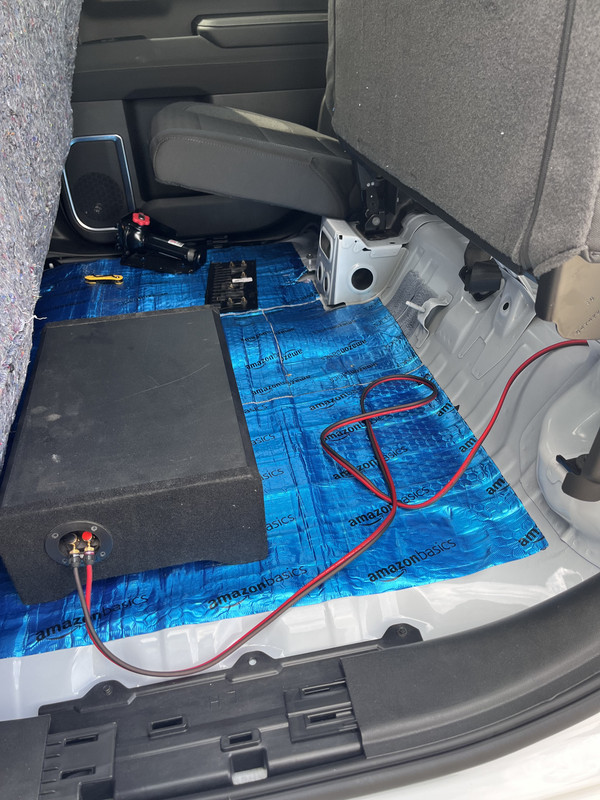- My Forums
- Tiger Rant
- LSU Recruiting
- SEC Rant
- Saints Talk
- Pelicans Talk
- More Sports Board
- Coaching Changes
- Fantasy Sports
- Golf Board
- Soccer Board
- O-T Lounge
- Tech Board
- Home/Garden Board
- Outdoor Board
- Health/Fitness Board
- Movie/TV Board
- Book Board
- Music Board
- Political Talk
- Money Talk
- Fark Board
- Gaming Board
- Travel Board
- Food/Drink Board
- Ticket Exchange
- TD Help Board
Customize My Forums- View All Forums
- Show Left Links
- Topic Sort Options
- Trending Topics
- Recent Topics
- Active Topics
Started By
Message
Car Audio - amp outputs polarity?
Posted on 5/5/23 at 3:17 pm
Posted on 5/5/23 at 3:17 pm
Maybe stupid question… but when checking output voltage of aftermarket amplifier, shouldn’t all of the outputs match the labeled polarity?
I was trying to troubleshoot something and when I checked voltage with multimeter, the front left & rear left (ch 1 & 3) have positive voltage but front right, rear right, & sub outputs (ch2, 4, & 5) have negative voltage. And even swapping polarity on inputs doesn’t change it positive. First time installing full audio system so bit confused.


Also while I’m here, question about mounting my shallow 10” sub… It seems easiest way to ensure minimal vibration is to drill through floor to bolt brackets, is that typically what people do? Or would simply setting on top of carpet and maybe fasten a simple strap or 2 will be good enough?

I was trying to troubleshoot something and when I checked voltage with multimeter, the front left & rear left (ch 1 & 3) have positive voltage but front right, rear right, & sub outputs (ch2, 4, & 5) have negative voltage. And even swapping polarity on inputs doesn’t change it positive. First time installing full audio system so bit confused.


Also while I’m here, question about mounting my shallow 10” sub… It seems easiest way to ensure minimal vibration is to drill through floor to bolt brackets, is that typically what people do? Or would simply setting on top of carpet and maybe fasten a simple strap or 2 will be good enough?

This post was edited on 5/5/23 at 3:25 pm
Posted on 5/5/23 at 3:46 pm to jyoung1
I don't know that I know enough to give you any advice but when you are referencing the polarity, what are you measuring between? Channel positive and channel Negative or Channel positive and ground?
I don't know if speaker outputs typically reference ground but it would not surprise me if they are typically floating. And unless you are pushing sound through them, I would not expect them to have much, if any voltage.
I don't know if speaker outputs typically reference ground but it would not surprise me if they are typically floating. And unless you are pushing sound through them, I would not expect them to have much, if any voltage.
Posted on 5/5/23 at 10:11 pm to jyoung1
Is your multimeter set to AC or DC? You measure speaker output voltage on AC, not DC.
Other than that not sure I can offer much help.
Other than that not sure I can offer much help.
This post was edited on 5/5/23 at 10:11 pm
Posted on 5/6/23 at 12:10 am to mdomingue
Either way it gives me same reading, and this was while playing music.
This post was edited on 5/6/23 at 12:10 am
Posted on 5/6/23 at 8:15 am to jyoung1
Are you getting sound out of all the speakers? It is possible your issue is related to the speaker or speaker wire on that channel rather than the amplifier itself. If any are not playing properly, try swapping a working and nonworking speaker connection to see if it follows the speaker or the channel.
And AC is the way to test the speaker output since the output to a speaker will be a sinusoidal wave to replicate what a sound wave looks like. Additionally, the speakers use coils to produce the sound which use AC to generate the field needed. While you could use pulsating DC to do the same thing that is much less efficient and adds complexity to the components as well as additional points of failure.
And AC is the way to test the speaker output since the output to a speaker will be a sinusoidal wave to replicate what a sound wave looks like. Additionally, the speakers use coils to produce the sound which use AC to generate the field needed. While you could use pulsating DC to do the same thing that is much less efficient and adds complexity to the components as well as additional points of failure.
This post was edited on 5/6/23 at 8:26 am
Posted on 5/6/23 at 3:33 pm to mdomingue
There isn’t any big issue really, I was actually troubleshooting something else (lost blinker sounds, fixed by adding Load generating device).
Im getting sound out of all speakers.
Ive confirmed that polarity is swapped because when installing my front right speaker today, with it wired correctly the woofer pushes in rather than out. And when i hook it up backwards the woofer pushes out correctly.
I understand the amp sends AC sine waves to speaker but my multimeter doesn’t tell me positive or negative with AC.
Im getting sound out of all speakers.
Ive confirmed that polarity is swapped because when installing my front right speaker today, with it wired correctly the woofer pushes in rather than out. And when i hook it up backwards the woofer pushes out correctly.
I understand the amp sends AC sine waves to speaker but my multimeter doesn’t tell me positive or negative with AC.
This post was edited on 5/6/23 at 3:34 pm
Posted on 5/6/23 at 5:17 pm to jyoung1
I have almost the same setup. Love the Lc7i.
I mounted my sub down and put L brackets to the bottom of my seat hinge.

I mounted my sub down and put L brackets to the bottom of my seat hinge.

Posted on 5/7/23 at 9:00 am to jyoung1
Easy way to check polarity - touch a 9V battery to the speaker wires. Make sure all speakers push in or out the same direction when connected to the battery +/- terminals. (also very handy to identify speaker wires if you have a big jumble of them)
The amp output is AC, your readings with a DMM will not mean much at all, as it is not fast enough to catch the rapid changes in frequency / amplitude. If you have an oscilloscope you could see it.
Rock on!

The amp output is AC, your readings with a DMM will not mean much at all, as it is not fast enough to catch the rapid changes in frequency / amplitude. If you have an oscilloscope you could see it.
Rock on!
Posted on 5/7/23 at 9:21 am to Geauxkart
quote:
If you have an oscilloscope you could see it.
Scope is the way to go but it's an expensive toy to have just hanging around
Posted on 5/7/23 at 12:15 pm to Geauxkart
Like I said, they are negative, I don’t understand why tho.
Posted on 5/7/23 at 1:49 pm to jyoung1
quote:
Maybe stupid question… but when checking output voltage of aftermarket amplifier, shouldn’t all of the outputs match the labeled polarity?
I was trying to troubleshoot something and when I checked voltage with multimeter, the front left & rear left (ch 1 & 3) have positive voltage but front right, rear right, & sub outputs (ch2, 4, & 5) have negative voltage. And even swapping polarity on inputs doesn’t change it positive. First time installing full audio system so bit confused.
It's not a stupid question at all! When checking the output voltage of an aftermarket amplifier, you would expect all of the outputs to match the labeled polarity. However, it's important to note that the polarity of the output voltage doesn't necessarily correspond to the polarity of the input signal.
If you're seeing negative voltage on some of the outputs, it could be an indication that the amplifier is producing an inverted signal on those channels. This is not uncommon and can be intentional or a result of the design of the amplifier.
If you're not sure if the negative voltage is normal for your particular amplifier, you should consult the manual or contact the manufacturer to confirm.
quote:
Also while I’m here, question about mounting my shallow 10” sub… It seems easiest way to ensure minimal vibration is to drill through floor to bolt brackets, is that typically what people do? Or would simply setting on top of carpet and maybe fasten a simple strap or 2 will be good enough?
Mounting a shallow 10" subwoofer can be done in several ways, and the choice of mounting method depends on personal preference, the type of vehicle, and the specific subwoofer and enclosure being used.
Bolting the subwoofer bracket to the floor of the vehicle can be an effective way to minimize vibration and ensure the subwoofer remains securely mounted. However, it requires drilling into the floor of the vehicle, which may not be desirable for some people. If you decide to go this route, make sure to choose a location that won't interfere with any important components of the vehicle and that the bolts are properly secured to prevent any rattling or movement.
Another option is to use a non-slip mat or padding between the subwoofer and the vehicle floor to help reduce vibrations. This can be effective but may not be as secure as bolting the subwoofer in place.
Using a simple strap or two to hold the subwoofer in place can also work, but it may not provide as much stability as other methods. Make sure the straps are properly secured and not too tight to avoid damaging the subwoofer or enclosure.
Posted on 5/7/23 at 2:05 pm to NPComb
Where did you copy and paste that from?
Popular
Back to top
 4
4








